
The Ultimate FCL Shipping Handbook: Costs, Benefits, and Best Practices for 2025
FCL shipping (Full Container Load) involves hiring an entire shipping container exclusively for your cargo, offering faster transit times an...
Discover how partnering with a 3PL (Third-Party Logistics) provider can help exporters simplify global supply chains, reduce logistics costs, and scale operations efficiently. From warehousing and customs clearance to advanced tracking and risk management, this guide breaks down the critical services and benefits exporters gain by choosing the right 3PL partner.

The global 3PL market stands at USD 1.16 trillion in 2025 and is projected to reachUSD 1.48 trillion by 2030 at a 5.1% CAGR. Yet, over 60% of 3PLs struggle with technology investment, making it the industry's biggest issue. For exporters, importers, and supply chain teams drowning in logistics complexity, third-party logistics providers aren't just service vendors—they're competitive lifelines.
Third-party logistics (3PL) refers to outsourcing your supply chain operations to specialized providers who handle everything from warehousing to freight management. For exporters and importers, 3PL companies serve as your single point of contact for comprehensive logistics solutions.
In fact, as per research published by Armstrong & Associates, 90% of Fortune 500 companies use third-party logistics providers. Unlike basic platforms that only compare freight rates, modern 3PLs offer end-to-end visibility and proactive problem-solving that logistics teams desperately need.

Strategically placed facilities ensure faster delivery and reduced shipping costs. Real-time inventory tracking provides the visibility that traditional freight solutions lack. Top-tier 3PLs optimize routes, consolidate shipments, and offer volume-based discounts.
Customs becomes a bottleneck for many exporters and importers. Good 3PLs don't just offer documentation—they navigate complex rules, ensure compliance, and maintain border authority relationships.
| Factor | In-House Logistics | 3PL Partnership |
|---|---|---|
| Technology Systems | $100K–500K+ annually | Included in service fees |
| Shipping Rates | Standard retail pricing | Volume-discounted rates |
| Compliance Risk | Full liability exposure | Shared risk management |
| Scalability | Limited by fixed assets | Instantly flexible |
As global demand for its innovative footwear surged, Vibram faced a major hurdle: its internal logistics systems couldn’t keep up. Instead of investing heavily in new warehouses or distribution channels, Vibram partnered with Barrett Distribution. The result? Barrett took over end-to-end warehousing and order fulfillment, processing thousands of shipments each day—while Vibram stayed focused on product innovation. This strategic 3PL partnership eliminated the need for costly infrastructure and unlocked faster, scalable global delivery.
Read the full case study Vibram Case Study.
Advanced tracking systems provide full visibility across your logistics chain—something basic freight platforms often can't. Leading 3PLs use AI for forecasting and route optimization. Since 2020, 87% of logistics providers have increased tech investments.

3PLs reduce per-unit shipping costs through freight consolidation. Their bulk shipping volumes unlock carrier discounts, saving you money. No need for warehouse leases, compliance teams, or asset investment—3PLs absorb that cost.
86% of companies aim to add new customers in 2024, and 50% are prioritizing warehouse automation. A reliable 3PL positions exporters and importers for scalable growth without operational bottlenecks.
As technology, regulations, and global trade policies evolve, your 3PL should help you stay ahead—not hold you back. The best providers invest heavily to future-proof your supply chain.
